Next Disney Live Action Movie After Beauty and the Beast
-
This article is about the 2017 live-action film. For the 1991 animated film, see Beauty and the Beast (1991 film).
Beauty and the Beast is an American musical romantic fantasy film directed by Bill Condon and distributed by Walt Disney Pictures. It is a live-action adaptation of the 1991 animated film of the same name and was written by Evan Spiliotopoulos and produced by Mandeville Films.
The script was rewritten by Stephen Chbosky. The film stars Emma Watson as Belle and Dan Stevens as the Beast, which was released on March 17, 2017.
The film received generally positive reviews from critics and audiences and has grossed $1.2 billion worldwide on a $254.6 million production budget, surpassing the original film, making it the second highest-grossing film of 2017.
Contents
- 1 Summary
- 2 Plot
- 3 Cast
- 4 Production
- 4.1 Development
- 4.2 Casting
- 4.3 Filming
- 5 Music
- 6 Reception
- 6.1 Controversies
- 6.2 Accolades
- 7 Box Office
- 8 Differences from the 1991 film
- 9 Releases
- 9.1 International Premieres
- 9.2 Home media
- 10 Gallery
- 11 Videos
- 11.1 Trailers and Clips
- 11.2 Interviews
- 12 Trivia
- 12.1 Cameos and other Disney references
- 13 References
- 14 External links
Summary
"Beauty and the Beast" is the fantastic journey of Belle, a bright, beautiful and independent young woman who is taken prisoner by a beast in his castle. Despite her fears, she befriends the castle's enchanted staff and learns to look beyond the Beast's hideous exterior and realize the kind heart and soul of the true Prince within.
Plot
In a vast castle of grandeur set in the heart of France, a handsome young prince is holding a ball to which the loveliest of women in all of the land were invited. They are all dancing away in the hope of winning the Prince's love and admiration as Madame de Garderobe sings. The party is interrupted when an old hag arrives at the castle in the hope of seeking shelter from the raging thunderstorm. All that she had to offer the Prince was a rose. However, the Prince is disgusted by her appearance and is infuriated due to the sudden disruption of the ball. He mocks her and declines the rose. The hag then transforms herself into a beautiful Enchantress, astonishing the Prince and scaring away all of his guests. The Prince begs for forgiveness, but the Enchantress has already seen that there is no love in his heart and hence transforms him into a hideous Beast. For further punishment, she also transforms his servants into household objects and she removes the villagers' memories of the Prince and the castle. She reveals the rose to be an enchanted rose and says that if the Prince hasn't learned to love another and gain love in return by the time the last petal falls from it, he would remain a Beast forever and his servants would permanently become non-living antiques.
Several years later, in the village of Villeneuve, a young bookworm and inventor named Belle is extremely bored of her village life and seeks excitement and adventure, contrary to the villagers who are very simple-minded and are quite happy where they are. They regard Belle as a very odd and "funny" girl. Belle lives with her father Maurice, a tinkerer and a music box maker. One day, Maurice and his horse, Philippe, leave for the market and asks Belle if she wants a gift when he returns home. Belle asks for a rose and for his safe return. Eventually, Gaston, who is considered as a hero by all in the village on account of his success in the battlefield proposes marriage to Belle. But Belle turns him down knowing that he is extremely arrogant and self-absorbed.
Meanwhile, Maurice and Philippe get lost in the forest while traveling to the market. While lost in the forest, they enter a part of the forest that is strangely covered in snow in June and are attacked by wolves, causing them to flee to the Beast's castle. While in the castle, Maurice experiences an eerieness and is startled by voices which seem to have no source. Though he didn't see his host, he saw that the table was served with dinner for one. Just as he is about to have dinner, Chip, the boy-turned-teacup, makes a sudden movement towards him and talks to him which utterly stuns Maurice. He immediately makes for the door and goes straight to Phillippe to escape the strange castle. On reaching near the gates, Maurice notices that the castle gardens have beautiful roses which reminds him of what Belle wished for. However, the Beast discovers Maurice plucking a rose from the castle's garden and detains him. Phillippe trots back to the village to find Belle. When Phillippe leads Belle to the castle, she offers to take her father's place in spite of her father's protests. The Beast accepts and sets her father free. Belle is released by the castle's footman, Lumière, who was turned into a candelabra as a result of the Enchantress's curse. Belle also meets the other castle residents who were also transformed by the curse; Cogsworth, the majordomo who is turned into a pendulum clock; Mrs. Potts, a teapot who is actually the cook; her son Chip, a teacup; Maestro Cadenza, one of the musicians who is now a harpsichord; Madame De Garderobe, Cadenza's wife is an opera singer and is now a wardrobe; their dog FrouFrou, a footstool; Chapeau, a coatrack who is actually a valet; Cuisinier, who is the castle's chef and a stove; and Plumette, a feather duster who is a maid and Lumière's fiancé.
After the staff offers Belle a meal, she wanders into the forbidden West Wing. The temperamental Beast discovers her and frightens her into fleeing into the woods. where she encounters the wolf pack that chased Maurice earlier. The Beast rescues Belle but he gets injured in the process. He begins to develop feelings for her while she nurses his wounds. The Beast allows Belle access to his library and the two begin to develop feelings for each other. While the Beast has fallen in love with Belle, Belle is uncertain of her feelings due to her imprisonment.
Meanwhile, Maurice returns to Villeneuve, but is unable to convince the townspeople to rescue Belle. Gaston, a hunter and former soldier who is trying to woo Belle, sees rescuing Belle from the Beast as an opportunity to win her hand in marriage and agrees to help Maurice. When Maurice learns of his ulterior motive and rejects him, Gaston ties Maurice up to a tree and abandons him in the forest so that the wolves will kill him. Maurice is rescued by a beggar, Agathe, but when he returns to the village and tells the townsfolk of Gaston's crime, Gaston convinces them to send Maurice to the town's insane asylum. Using the magic mirror, Belle sees Maurice being captured and the Beast allows her to leave to save him, letting her keep the mirror to see him again. At Villeneuve, Belle rescues Maurice and proves his sanity by showing the Beast with the magic mirror. Realizing that Belle loves the Beast, Gaston locks Belle up with her father and convinces the villagers that the Beast is a man-eating monster, leading them to the castle to kill him. However, Maurice and Belle escape from confinement and Belle rushes back to the castle to warn the Beast.
While the villagers are fended off by the servants, Gaston fights the Beast. The Beast initially is too depressed to retaliate but regains his will after seeing Belle return to the castle. He corners Gaston and spares his life before trying to reunite with Belle. Before he can do so, Gaston fatally shoots the Beast twice in the back. Gaston then falls to his death as a result of the stone bridge that he is standing on crumbling beneath him. The Beast dies of Gaston's gunshots as the last petal falls from the rose and the servants become completely inanimate. Belle tearfully professes her love to him and kisses his forehead. While watching the scene and realizing the Beast has fulfilled the goal of loving Belle and earning her love in return, Agathe reveals herself as the Enchantress and undoes the curse, returning the Prince and his servants to their true forms and restoring the castle to its former glory. The village inhabitants return to the castle with their true memories restored and reunited with their loved ones, and the Prince and Belle are married and host a ball for the kingdom at which they dance to celebrate the couple's wedding.
Cast
- Emma Watson as Belle
- Daisy Duczmal as infant Belle
- Dan Stevens as Beast/the Prince
- Adam Mitchell (miscredited in the cast list as Rudi Goodman) as young Prince
- Luke Evans as Gaston
- Kevin Kline as Maurice
- Jolyon Coy as young Maurice
- Josh Gad as LeFou
- Ewan McGregor as Lumière
- Stanley Tucci as Maestro Cadenza
- Audra McDonald as Madame de Garderobe
- Gugu Mbatha-Raw as Plumette
- Hattie Morahan as the Enchantress/Agathe
- Rita Davies as the Enchantress disguised as an old woman
- Nathan Mack as Chip
- Ian McKellen as Cogsworth
- Emma Thompson as Mrs. Potts
- Thomas Padden as Chapeau
- Gizmo as FrouFrou
- Clive Rowe as Cuisinier
- Adrian Schiller as Monsieur D'Arque
- Jimmy Johnston, Dean Street, and Alexis Loizon as Gaston's Buddies
- Sophie Reid, Rafaëlle Cohen, and Carla Nella as the Village Lasses
- Zoe Rainey as Belle's mother
- Gerard Horan as Monsieur Jean the Potter
- Tom Turner (miscredited in the cast list as Henry Garrett) as the King
- Harriet Jones as the Queen
- Ray Fearon as Père Robert
- Stephen Merchant as Monsieur Toilette (deleted scene)
Production
Development
Development of the film began in April 2014. In the same month, Bill Condon was signed to direct the film, with a script by Evan Spiliotopoulos. Later, in September 2014, Stephen Chbosky was hired to re-write the script.
Casting
Emma Watson was announced as the lead role as Belle in January 2015, Two months later, in March of 2015, actors Luke Evans and Dan Stevens were revealed to be in talks to play Gaston and the Beast respectively in the film. Josh Gad was confirmed to play LeFou in the film. Emma Thompson, Kevin Kline, Audra McDonald, Ian McKellen, Gugu Mbatha-Raw, Ewan McGregor, and Stanley Tucci also joined the cast in March of 2015.
Filming
Filming began on May 18, 2015 and ended on August 21, 2015. Six days later, it was announced that the film had officially wrapped up production.
The Beast however was portrayed in a motion-capture sequence, where actor Dan Stevens wore a giant forty-pound gray suit, while the facial capture was done separately.
Music
- Main article: Beauty and the Beast (2017 soundtrack)
The soundtrack was released by Walt Disney Records on March 10, 2017.
Reception
The film has received generally positive reviews, with critics mostly praising the faithfulness to the animated film and elements of the Broadway musical version, performances, visuals, settings, costume design, and songs, while some mixed reactions were drawn towards the CGI look of the Beast and household objects and for its excessive similarity to the original 1991 animated film.
On the review aggregator Rotten Tomatoes, the film has an approval rating of 71% based on 350 reviews, with an average rating of 6.69/10. The site's critical consensus reads, "With an enchanting cast, beautifully crafted songs, and a painterly eye for detail, Beauty and the Beast offers a faithful yet fresh retelling that honors its beloved source material." On Metacritic, the film has a score of 65 out of 100, based on 47 critics, indicating "generally favorable reviews". In CinemaScore polls, audiences gave the film an average grade of "A" on an A+ to F scale.
Owen Gleiberman of Variety, in his positive review of the film, wrote: "It's a lovingly crafted movie, and in many ways a good one, but before that, it's an enraptured piece of old-is-new nostalgia."
A. O. Scott of The New York Times praised the performances of both Watson and Stevens and wrote: "It looks good, moves gracefully, and leaves a clean and invigorating aftertaste. I almost didn't recognize the flavor: I think the name for it is joy."
Mike Ryan of Uproxx praised the cast, production design, and the new songs while noting the film doesn't try anything different, saying: "There's certainly nothing that new about this version of Beauty and the Beast (well, except it isn't a cartoon anymore), but it's a good recreation of a classic animated film that should leave most die-hards satisfied."
Conversely, Michael Phillips of the Chicago Tribune said the adaption got lost in translation, writing, "The movie takes our knowledge and our interest in the material for granted. It zips from one number to another, throwing a ton of frenetically edited eye candy at the screen, charmlessly."
Wendy Ide and Peter Bradshaw of The Guardian also gave a mixed review of the film. Ide wrote negatively, criticizing that the film was too, "ornate to the point of desperation", in trying to justify its existence and live up to the animated film. In contrast to her review, Bradshaw gave a positive remark, writing, "The whole movie is lit in that fascinatingly artificial honey-glow light, and it runs smoothly on rails – the kind of rails that bring in and out the stage sets for the lucrative Broadway touring version."
In his negative review of the film, Joe Morgenstern of the Wall Street Journal describes the adaption as one where, "Enchantment is chased, and never captured, in extravagant set pieces that owe less to fairytale tradition than to Cirque du Soleil grandiosity."
Controversies
Sixteen days prior to the film's release, director Bill Condon suggested that LeFou, portrayed by Josh Gad in the film, would be Disney's first openly gay character. Though this concept was widely praised, there was backlash by certain organizations and governments.
A theater in Henagar, Alabama refused to screen the film due to LeFou's sexuality. In Russia, the country had initially decided to ban the film from every theater before declaring that it would have a theatrical run. However, no one under 16 years of age was allowed to see it. In Malaysia, the Film Censorship Board requested that Disney cut the scene where LeFou is dancing with another man, resulting in the studio moving the country's release date to March 30 to allow more time for the board to think things over. The board then decided to release the film with a PG-13 rating, to which Disney agreed. In Kuwait, the film was banned from the country's theaters entirely.
Accolades
Beauty and the Beast received two nominations for an Academy Award for Best Costume Design for Jacqueline Durran, and Academy Award for Best Production Design for Sarah Greenwood and Katie Spencer (of which the three also received nominations simultaneously for Joe Wright's war drama film, Darkest Hour in the same categories) at the 90th Academy Awards, losing its two wins to Paul Thomas Anderson's historical drama film, Phantom Thread (for the Best Costume Design) and Guillermo del Toro's romantic dark fantasy film, The Shape of Water (for the Best Production Design).
Box Office
As of June 16, 2017, Beauty and the Beast has grossed $504 million in the United States and Canada and $759 million in other territories for a worldwide gross of $1,263,521,126. With a production budget of $160 million it is the most expensive musical ever made; only Hello, Dolly! (1969) with a budget of $25 million ($165 million in 2016 dollars) cost more. In just ten days, it became the highest-grossing live-action musical of all time, supplanting the nine-year-old record held by Universal Pictures' Mamma Mia!; It is currently the third biggest musical ever overall, behind Frozen (which also featured Josh Gad) and The Lion King (also both owned by Disney). Worldwide, the film proved to be a global phenomenon as it earned a total of $357 million on its four days opening weekend from 56 markets. Critics said the film was playing like superhero movies amongst women. That's the second biggest March global opening, behind only Batman v Superman, the thirteenth-biggest worldwide opening ever and the seventh-biggest for Disney. This includes $21 million from IMAX plays on 1,026 screens, a new record for an IMAX PG title. It surpassed the entire lifetime total of the original film in just six days and made a quarter of a billion dollars in just nine days.
Beauty and the Beast is the 300th digitally remastered release in IMAX company's history which began with the re-release of Apollo 13 in 2002. Its robust global debut helped push the company past $6 billion for the first time and led to analysts believing that the film has a shot of passing $1 billion worldwide from theatrical earnings.
In the United States and Canada, Beauty and the Beast topped Fandango's pre-sales and became the fastest-selling family film in the company's history, topping the studio's own animated film Finding Dory released the previous year. Early tracking had the film grossing around $100 million in its opening weekend, with some publications predicting it could reach $130 million. By the time the film's release was 10 days away, analysts raised projections to as high as $150 million. It earned $16.3 million from Thursday previews night, marking the biggest of 2017 (breaking Logan's record), the biggest ever for a Disney live-action film (breaking Maleficent's record), the second biggest ever for both a G or PG-rated film (behind the sixth Harry Potter film Harry Potter and the Half-Blood Prince which also starred Watson), and the third biggest ever in the month of March (behind Batman v Superman: Dawn of Justice and The Hunger Games). An estimated 41% of the gross came from IMAX, 3D, and premium large format screenings which began at 6 pm, while the rest – 59% – came from regular 2D shows which began at 7 pm. The numbers were considered more impressive given that the film played during a school week.
On its opening day, the film made $63.8 million from 4,210 theaters across 9,200 screens, marking the third biggest in the month of March, trailing behind Batman v Superman ($81.5 million) and The Hunger Games ($67 million). It was also the biggest opening day ever for a film that wasn't PG-13, displacing the $58 million opening Wednesday of Harry Potter and the Half-Blood Prince. Its opening day alone (which includes Thursday's previews) almost matched the entire opening weekend of previous Disney live-action films, Maleficent ($69 million) and Cinderella ($67 million). Unlike all previous four Disney live-action films witnessing a hike on their second day, Saturday, Beauty and the Beast actually fell -2%, but nevertheless, the dip was paltry, and the grosses are so much bigger compared to the other titles. Earning a total of $174.8 million on its opening weekend, it defied all expectations and went on to set numerous notable records. This includes the biggest opening of the year as well as the biggest for the month of March and pre-summer/Spring opening, beating Batman v Superman, the biggest start ever for a PG title (also for a family film), surpassing Finding Dory, the biggest debut of all time for a female-fueled film, ahead of The Hunger Games: Catching Fire, the biggest for a Disney live-action adaptation, ahead of Alice in Wonderland and the biggest musical debut ever, supplanting Pitch Perfect 2. Furthermore, it is also Watson's highest-opening of all-time, beating Harry Potter and the Deathly Hallows – Part 2 same with Emma Thompson, director Bill Condon's biggest debut ever ahead of The Twilight Saga: Breaking Dawn – Part 2 and the biggest outside of summer, save for Star Wars: The Force Awakens, not accounting for inflation.
It became the forty-third film to debut with over $100 million and the fifteenth film to open above $150 million. Its three -ay opening alone surpassed the entire original North American run of the first film ($146 million; before the 3D re-release), instantly became the second -iggest film of the year, behind Logan ($184 million), and also the second highest-grossing musical, just behind Grease's $188 million cumulative gross in 1978. 70% of the total ticket sales came from 2D showings signifying that people who don't go to theaters frequently came out in bulk to watch the film. About 26% of the remaining tickets were for 3D. IMAX accounted for 7% ($12.5 million) of the total weekend's gross, setting a new record for a PG title, ahead of Alice in Wonderland ($12.1 million) while PLF repped 11% of the box office. Females represented a staggering 70% of the film's total demographic on its opening day which eased out to 60% throughout the entire weekend. According to polling service PostTrak, about 84 percent of American parents who saw the film on its opening day said they would "definitely" recommend it for families. The film's huge opening was credited to positive word of mouth from audiences, good reviews from critics, effective marketing which sold the title not just as a kid-friendly film but also as a romantic drama, the cast's star power (especially Emma Watson), lack of competition, being the first family-driven film since The Lego Batman Movie a month earlier, nostalgia, the success, and ubiquity of the first film and Disney's brand.
On Monday, its fourth day of release, the film fell precipitously by 72% earning $13.5 million. The steep fall was due to a limited marketplace where only 11% K-12 and 15% of colleges were off per ComScore. Nevertheless, it is the second-biggest March Monday, behind Batman v Superman ($15 million). This was followed by the biggest March and pre-summer Tuesday with $17.8 million, a +32% increase from its previous day. The same day, the film passed $200 million in ticket sales. It earned $228.6 million in the first week of release, the sixth-biggest seven-day gross of all time. In its second weekend, the film continued to maintain the top positioning and fell gradually by 48% earning another $90.4 million to register the fourth-biggest second weekend of all time, and the third-biggest for Disney. In terms of percentage drop, its 48% decline is the third-smallest drop for any film opening above $125 million (behind Finding Dory and The Force Awakens). The hold was notable considering how the film was able to fend off three new wide release; Power Rangers, Life, and CHiPs. As a result, it passed the $300 million thresholds becoming the first film of 2017 the pass the said mark.
Internationally, the film began playing on Thursday, March 16, 2017. Through Sunday, March 19, it had a total international opening of $182.3 million from 55 markets, 44 of which were major territories, far exceeding initial estimations of $100 million and opened at No. 1 in virtually all markets save Vietnam, Turkey, and India. Its launch is the second biggest for the month of March, behind Batman v Superman ($256.5 million). In IMAX, it made a recorded the biggest debut for a PG title with $8.5 million from 649 screens, the second biggest for a PG title behind The Jungle Book. In its second weekend, it fell just by -35% earning another $120.6 million and maintaining its first position hold. It added major markets like France and Australia.
It scored the biggest opening day of the year in Hong Kong and the Philippines (where it is the sixth highest-grossing film of all time), the biggest March Thursday in Italy ($1 million, also the biggest Disney Thursday debut), the biggest March opening day in Austria, and the second biggest in Germany ($1.1 million), Disney's biggest March in Denmark, the biggest Disney live-action debut in China ($12.6 million), the UK ($6.2 million), Mexico ($2.4 million), Brazil ($1.8 million), and the third biggest in South Korea with $1.2 million, behind only Pirates of the Caribbean: At World's End and Pirates of the Caribbean: On Stranger Tides. In terms of opening weekend, the largest debut came from China ($44.8 million), followed by the UK ($24.3 million), Korea ($11.8 million), Mexico ($11.8 million), Austalia ($11.1 million), Brazil ($11 million), Germany ($10.7 million), France ($8.4 million), Italy ($7.6 million), Russia ($6 million), and Spain ($5.8 million).
In the United Kingdom and Ireland, the film recorded the biggest opening ever for a PG film, the biggest Disney live-action opening of all time, the biggest March opening weekend, the biggest opening for a musical (ahead of Les Misérables), the number one opening of 2017 to date and the fifth-biggest ever overall with £19.7 million ($24.5 million) from 639 theatres and almost twice that of The Jungle Book (£9.9 million). This included the second biggest Saturday ever (£7.9 million), only behind Star Wars: The Force Awakens. It witnessed a decent in its second weekend, earning £12.33 million ($15.4 million). Though the film was falling at a faster rate than The Jungle Book, it had already surpassed the said film and its sophomore weekend is the third biggest ever (behind the two James Bond films Skyfall (2012) and Spectre). In India, despite facing heavy competitions from four new Hindi releases, two Tamils films, and a Malayalam and a Punjabi release, the film managed to take occupancy of 15% on its opening day, an impressive feat despite such tremendous competitions. It earned around ₹1.5 crore (US$220,000) nett on its opening day from an estimated 600 screens which are more than the three Hindi releases – Machine, Trapped, and Aa Gaya Hero – combined. Disney reported a total of ₹9.26 crore (US$1.4 million) gross for its opening weekend there. It was ahead of all new releases and second overall behind Bollywood film Badrinath Ki Dulhania. In Russia, despite receiving a restrictive 16 rating, the film managed to deliver a very successful opening with $6 million.
In China, expectations were high for the film. The release date was announced on January 24, giving Disney and local distributor China Film Group Corporation ample time – around two months – to market the film nationwide. The release date was strategically chosen to coincide with the White Day. Preliminary reports suggested that it could open to $40–60 million in its opening weekend. Largely driven by young women, its opening day pre-sales outpaced that of The Jungle Book. The original film was however never widely popular in the country. Although China has occasionally blocked gay-themed content from streaming video services, in this case, Chinese censors decided to leave the gay scene intact. According to local box office tracker Ent Group, the film grossed an estimated $12.1 million on its opening day (Friday), representing 70% of the total receipts. Including previews, it made a total of $14.5 million from 100,000 screenings, which is 43% of all screenings in the country. It climbed to $18.5 million on Saturday (102,700 showings) for a three day total of $42.6 million, securing 60% of the total marketplace. Disney, on the other hand, reported a different figure of $44.8 million. Either way, it recorded the second biggest opening for a Disney live-action film, with $3.4 million coming from 386 IMAX screens.
The only markets where the film did not top the weekend charts were Vietnam (behind Kong: Skull Island), Turkey (with two local movies and Logan ahead), and India (where Badrinath Ki Dulhania retained No. 1). It topped the box office for four straight weekends in Germany, Korea, Austria, Finland, Poland, Portugal, Brazil, Venezuela, Bolivia, Switzerland, and the UK (exclusive of previews). In the Philippines, it emerged as the most successful commercial film of all time—both local and foreign—with over $13.5 million. In just five weeks, the film became one of the top 10 highest-grossing films of all time in the United Kingdom and Ireland, ahead of all but one Harry Potter film (Deathly Hallows – Part 2) and all three The Lord of the Rings movies (which also starred Ian McKellen). It is currently the eighth-biggest grosser with £70.1 million ($90 million), overtaking Mamma Mia! to become the biggest musical production ever there. The biggest international earning markets following the UK are Japan ($108 million), China ($85.8 million), Brazil ($41.5 million), Korea ($37.5 million), and Australia ($35 million). In Europe alone, the cumulative total is $267 million to become the second-highest-grossing film in the past year (behind Rogue One: A Star Wars Story).
Differences from the 1991 film
- Unlike the animated film, the Prince is already a grown-up when he is cursed. In the animated film, it was implied that the Prince was younger when he was cursed. Also, the actual length of the curse is never mentioned, while in the animated film it was mentioned that the curse's limit would reach by the end of the Beast's twenty-first year, where it is mentioned the curse was cast ten years ago. He is however shown as an 11-year old in a flashback sequence during "Days in the Sun". None of the characters age during the sequence at the time, whereas in the animated version, the Beast is the only one who is confirmed to age.
- The curse also adds that the castle and forest are to be placed in eternal winter in this version, with the village itself under summer months. In the original film, it was subtly implied that the film took place from late fall to early spring regarding the changing seasons.
- Due to the castle being cursed with eternal winter, a thunderstorm does not occur when Maurice enters the castle, nor does it happen when Gaston attempts to murder the Beast, although it only rains when Gaston and LeFou arrive at the tavern where Maurice would take the opportunity to expose Gaston's true nature to the villagers, once again without any success.
- Similarly, the villagers were shown to have forgotten about the castle and its inhabitants in this version as a result of the curse. In the original film, they simply were unaware of the castle in the first place.
- The remake also expands a bit on the Beast's backstory prior to the curse. In particular, it was revealed that a large part of Beast's coldness and selfish nature was caused by his cruel upbringing due to his father's negative influence especially after his mother's death. It also reveals that most of the occupants besides the prince ended up being cursed due to their failure to step in and stop the prince when they had the chance, while in the original film it was never revealed why the servants were cursed beside the fact that the enchantress punished the Beast.
- Belle's backstory is elaborated on in this film, where it is revealed that the reason why Belle and Maurice moved to the village in the first place was that they were trying to escape a plague in Paris, said plague is also the reason why Belle's mother wasn't with them in the village. Originally, it was only mentioned once very briefly in the opening song that Belle and Maurice had moved to the village in the past with no elaboration on why or when they had moved there, and Belle's mother was not mentioned at all in the original film.
- The beginning of the story is told more realistically while in the original, it is told through narration and the views of stained glass windows.
- The narrator is an unseen male character in the original film; in the remake, the Enchantress is the narrator.
- The servants (in their human forms) make their first physical appearance near the beginning of the film prior to the Enchantress cast her spell, instead of appearing as enchanted objects when Maurice enters the castle. The ones who speak are Plumette (who says "Poof poof!" when she puts makeup on the Prince's face), Cogsworth (who informs the Prince that the ball is going to begin), Lumière (who speaks to the Prince in French "Oui, maître."), Madame de Garderobe (who sings during the ball), and Mrs. Potts (who calls out for her son Chip after the Enchantress reveals her true form to the Prince and his astonished guests flee the scene in terror).
- New characters are added to the film, while some original characters are renamed or added with new names:
- The Wardrobe is renamed Garderobe in the 2017 film.
- Cadenza is a new character added for the 2017 film. He is the husband of Garderobe.
- Sultan is renamed Froufrou in the 2017 film. Also, he is Garderobe and Cadenza's pet dog instead of just being the palace dog.
- Fifi is renamed Plumette in the 2017 film. She also has a larger role in the 2017 film. Also, instead of Lumière and her simply flirting with one another, they are clearly devoted to each other in the new version.
- The Bimbettes are credited as the Village Lasses.
- Chef Bouche is renamed Cuisinier in the 2017 film.
- The Coat Rack is named Chapeau in the 2017 film, and he has a bigger role as the valet.
- When the servants are revived as humans, Cogsworth's human name, Henri, is revealed by his wife, Clothilde, as well Mrs. Potts' first name, Beatrice, which was mentioned by her husband, Monsieur Jean Potts.
- Three new songs were written and composed for the film, in addition to the original songs featured in the animated version, except for the reprise song of Gaston.
- None of the Broadway songs were present, not even "Human Again", which was present for the 2002 Special Edition of the animated film although the instrumental version of the Broadway song "Home" was featured in this film.
- Some of the lines of "Gaston" and "The Mob Song" were changed.
- Several characters have different designs due to the medium of live-action:
- The Beast's physical appearance had minor changes: Instead of a combining features of various animals, he resembles more explicitly an anthropomorphic lion and his pair of horns features like an antelope instead of a buffalo. Also, his wild boar-like tusks and wolf-like tail are completely omitted in the 2017 film.
- Many of the enchanted objects inside the castle are changed: Mrs. Potts' face is now on the right side of the teapot instead of on the spout (they were originally going to have it at the spout, but the teapot ended up looking like an elephant); Lumière somewhat appears to be a golden sculptured human figure candlestick but when he transforms, his figure of a candlestick with three branches still remains; Cogsworth's designs particularly the frontal base features a variety of weapon and object figures such as cannon, cannonballs, sword, spear, blunderbuss rifle, pistol, quill, amulets, and a pocket watch that covers the frontal base instead of a glass cover though the pendulum remains intact but hidden and also has Roman numerals on his face and when he transforms back into a human, they are on his coat buttons; Froufrou retains the figure of a footstool but somehow resembles the form of a piano bench and upon transforming in his normal self, he resembles as a Yorkshire Terrier breed; Garderobe's face is inside the wardrobe instead of on the top, and Plumette resembles a miniature swan/peacock rather than an ordinary feather duster.
- Unlike the original film, Lumiere's copper hair is implied to be cut short and hidden under the powdered wig he wore in human form. He also has a brownish auburn mustache and goatee. Like the novel, Lumiere is implied to be the footman rather than maitre d', like he was in the original animated film.
- Cogsworth is depicted as an old man with a white wig, unlike the original animated film where he wore a brown wig and is implied to be a middle-aged man.
- Gaston has a light mustache in this film. He is also known for being a former soldier, an army captain, who had once fought off Portuguese marauders (according to Luke Evans in an interview) and saved the village during the war, rather than as just a local hero, hunter and tavern owner. Unlike the animated film, his muscular figure is removed.
- The triplets were depicted as having dark curly hair as well as very dolled-up appearances, bonnets, and lavish pink dresses. In the original film, the triplets were depicted as being blonde, voluptuous, and wearing simple yet revealing dresses.
- LeFou is taller than his animated counterpart.
- Unlike the animated film, Maurice is an artist and a music box maker rather than an inventor. Belle is an inventor instead. This change had been made at the request of Belle's actress in the film, Emma Watson.
- The village is named Villeneuve in the remake.
- In the animated film, Belle's house is outside of the village. In this film, it is inside.
- Belle is shown reading a book to a young girl. This doesn't happen in the original film.
- This version of Gaston is more aggressive and violent in nature than his animated counterpart, although he shows some sense of humor.
- During Gaston and LeFou's first appearance, they are seen traveling into town on horses. In the original, they are instead seen shooting ducks, but were already in the town.
- Gaston also had flowers which he used to try to propose to Belle, which fails.
- Gaston and LeFou do not throw a wedding for Belle; instead, Gaston tries to propose to Belle a second time, once again to no avail.
- An explosion does not happen from within Belle's house.
- Unlike the animated film, the Enchantress gave the Beast not only the enchanted rose and the mirror but also a book that enables him to transport to a particular place.
- Maurice leaves to go to the market with Philippe in the remake while in the animated film, he and Philippe leave to go to a fair to present Maurice's wood chopping machine.
- The wood chopping machine does not appear in the remake.
- In the remake, Maurice and Philippe lose their wagon while fleeing from the wolves. In the original, Philippe still had it with him while fleeing and it is later removed by Belle.
- While traveling through the woods in the original film, Philippe wanted to take the left path but Maurice instead wants to take the right path, which he thinks is a shortcut. In the remake, a fallen tree blocks the left path, forcing Maurice and Philippe to take the right path.
- While fleeing from the wolves, Maurice and Philippe do not almost run off a cliff.
- When Maurice approaches the castle gates, it opens and closes by itself; in the animated version, Maurice opens it himself and then closes it to stop the pursuing wolves from attacking him.
- The wolves don't try to force their way through the gate. Instead, they simply stop chasing Maurice.
- When Maurice enters the castle, the scenes that follow borrow heavily from the original fairy tale instead of the animated film: he doesn't interact with the Beast's servants (nor does he realize they are enchanted), and is served a meal as a sign of hospitality. He does, however, see Chip, who scares him away when he speaks in front of him.
- Maurice is also imprisoned in the castle only because of a rose he picked for Belle, like the original fairy tale.
- Largely because of this change, Philippe does not actually flee until after Beast tries to chase after Maurice for the theft.
- Maurice is also imprisoned in the castle only because of a rose he picked for Belle, like the original fairy tale.
- Belle arrives at the castle during the day instead of at night.
- Chip doesn't have any siblings in the remake.
- Mrs. Potts uses her tea cart more often in the remake.
- In the original film, Lumière and Cogsworth lead Belle to where Maurice is. In the remake, they don't do that. Belle instead hears Maurice and uses Lumière as a light source to find him.
- After Belle agreed to take her father's place, the Beast simply throws him out while in the animated film, he throws Maurice into a horseless, walking carriage called a palanquin and orders it to take him back to the village.
- The palanquin does not appear in the remake.
- In the remake, Garderobe dresses up Belle in a bizarre fashion when first meeting her. In the animated film, she doesn't do this; instead, she looks for something that Belle can wear for dinner.
- When Chip does the bubble-blowing trick in the remake, he creates a single large bubble. In the animated film, he creates multiple little bubbles.
- In the remake, when Chip tells Mrs. Potts about Belle's arrival, she already knew about it. In the original film, she didn't believe Chip until Fifi brings her the news.
- In that same scene, Mrs. Potts wasn't giving Chip a bath.
- When the Beast tries to get Belle to eat dinner with her, she is seen trying to escape through the bedroom window down a rope made of clothes. She never did this in the original film.
- Whenever a petal falls, parts of the castle will collapse and the staff gradually lose their humanity, becoming more inanimate over time. This was not present in the animated film, although the latter aspect was present in the musical.
- Gaston's buddies consist only of the three referred in both films as Tom, Dick, and Stanley, without the fourth man. They are also the ones who sing the section of the opening song calling Belle "peculiar", and they are the ones who get dressed as women by the wardrobe during the battle.
- The Beast does not release Belle from the dungeon nor does he bring her to her bedroom. Lumière (followed by Cogsworth) does this instead.
- While heading to the bedroom, they travel across a walkway that's outside of the castle. They never did this in the animated film. It was still daytime at this point while in the animated film, it was night.
- When they mention the West Wing, they don't say it is forbidden.
- The bedroom is octagonal-shaped and has more decorative decals than its animated counterpart.
- The dinner scene has several differences:
- Lumière doesn't encourage the Beast to invite Belle to dinner; instead, Mrs. Potts and Garderobe try to convince Belle to go to dinner.
- The Beast does not wait in the dining room for Belle. Instead, he comes in while the servants are preparing the table and explain their plan to him.
- When Beast tries to learn how to smile, he does it in front of Belle's bedroom instead of in the dining room.
- In the animated film, the Beast angrily runs upstairs after learning that Belle isn't coming down, pounds on her door, and yells at her to come down. In this film, he instead visits her normally and knocks on her door instead of pounding on it. He doesn't yell until after Belle refuses to have dinner with him.
- Plumette and Chip were with the Beast, Lumière, Cogsworth, and Mrs. Potts when they visit Belle's room.
- In the original film, when the Beast storms into the West Wing after failing to convince Belle to eat dinner with him, he knocks a chair aside. In the remake, he instead knocks down a candle stand.
- In the original film, Lumière and Cogsworth were with Belle when she gets curious about the West Wing and they try to lead her away by telling her about the castle's library. In the remake, Mrs. Potts was with Belle instead, but she doesn't try to stop Belle from entering the West Wing; instead, she just tells her to go to bed.
- The West Wing is brighter and cleaner than its animated counterpart as there is little to no wrecked furniture.
- The monster statues and moving suits of armor found in the castle hallways do not appear in the remake.
- The broken mirror that Belle passes by does not appear the corridor leading to the West Wing. It is instead seen in the West Wing itself. Belle's reflection does not appear on it (due to the fact that she's at a far distance from it).
- The mirror is rectangle-shaped instead of oval-shaped and is larger than its animated counterpart.
- The portrait that the Beast scratches at the beginning of the film is larger in the remake and also shows the Prince's family. It was also scratched more than once.
- When Belle sees it, she doesn't try to realign the scratched areas (this is mostly due to the fact that the canvas is not made of fabric).
- The handles on the door leading to the West Wing do not resemble a monster face.
- While wondering into the West Wing, Belle doesn't almost accidentally knock over a small table.
- When attempting to touch the rose, Belle does not remove its glass case.
- When the Beast yells at Belle to get out of the West Wing, he doesn't smash any furniture.
- In the animated film, when Belle tries to flee the castle, Lumière and Cogsworth try to convince her not to. In the remake, they, along with Mrs. Potts, Chapeau, and Froufrou, try to stop her while warning her of the wolves in the forest.
- Lumière and Cogsworth were playing chess at that time.
- The castle's windows and doors close and lock themselves in an attempt to stop Belle from leaving.
- During the second wolf attack:
- Instead of falling through a frozen pond like in the 1991 film, Philippe slips and slides on it, giving the wolves an advantage to catch up and bite his legs, and when one wolf jumps on Philippe, Belle jumps off (instead of being thrown off like in the 1991 film) to grab a stick.
- In this version, one wolf grabs the stick Belle is using and throws it away instead of breaking it in half like in the 1991 version. Afterward, Belle is standing up instead of being pulled down. When the scar-eye wolf pounces, the Beast pounces it in midair and throws it against a fallen log, scattering the others, whereas in the 1991 version, a random wolf pounces and is caught in midair by the Beast's paws, the Beast roars in its face and throws it away before confronting the others.
- In this version, the Beast throws the wolf with the scar on its eye against a fallen log, and roars at it, intimidating it into whimpering to the others and running away with them in hot pursuit. In the 1991 film, he throws one wolf hard against a tree, murdering it and causing the others to run away yelping.
- During "Something There", Belle and the Beast actually sing, unlike in the animated film, where their singing voices are only through their thoughts during the scene.
- In the animated film, when the Beast was about to throw a large snowball at Belle, she counters it by throwing another snowball at him. In the remake, Belle doesn't do that at all and the Beast was able to successfully throw his snowball at her.
- Before "Be Our Guest", Cogsworth doesn't get knocked into a bowl of pudding.
- In the remake, Gaston actively tries to murder Maurice when he refuses to give Gaston his blessing in order to marry Belle. As a result, he ties Maurice up to a tree, hoping for the wolves to devour him. In the animated film, he only tried to expose him as a lunatic.
- The latter plan is carried later on, although Gaston offers Maurice to release him from the asylum carriage if he allows him to marry Belle, while in the animated film, Gaston offered Belle to release Maurice if she married him.
- The remake also has Gaston trick the villagers into thinking Maurice was insane, while the original film implies with the "Gaston" reprise that most if not all of the villagers supported the plan despite knowing full well he wasn't actually dangerous.
- The latter plan is carried later on, although Gaston offers Maurice to release him from the asylum carriage if he allows him to marry Belle, while in the animated film, Gaston offered Belle to release Maurice if she married him.
- In the woods, Belle does not save Maurice. Instead, it is the Enchantress, under the guise of Agathe.
- The castle's library is smaller than its animated counterpart. In addition, the Beast doesn't show it to Belle as a surprise.
- Unlike the animated film, when Belle doesn't find out about the spell until the very end, she is told of it by the servants during her stay at the castle, though they don't tell her how it can be broken when she asks them.
- Mrs. Potts is the one who confirms the Beast's love for Belle, instead of the Beast himself.
- During the musical number, "Beauty and the Beast":
- The line "Just a little change," had Belle and the Beast having dinner with a castle servant playing a violin serenading them while in the remake, it had the couple walk past Lumiere, Cogsworth, and Cadenza seeing them.
- There are background instruments playing by themselves during the scene where Belle and the Beast dance in the ballroom together in the remake.
- The scene where Mrs. Potts tells Chip to go to bed was omitted in this film.
- Monsieur D'Arque has a less, yet shorter defined role. He only appears briefly during the scene when he commandeers an asylum carriage containing Maurice. He serves as a guard in watching the detained Maurice and Belle, only for the latter to escape. The scene in a tavern involving Gaston bribing Monsieur D'Arque with a sack of money and detailing his plan of marriage to Belle is notably absent.
- Unlike the animated film, the Bimbettes and the village women also participate in "The Mob Song" and the castle fight.
- In addition, the Village Lasses are shown to hate Belle (with Bill Condon and Rafaelle Cohen strongly implying it dealt with their mother doting on Belle over them), whereas their animated counterparts showed no ill will towards Belle.
- The Bimbettes' job professions have changed, being seamstresses in the remake. In the original film, it was heavily implied they were waitresses to Gaston's tavern.
- The Bimbettes were given different appearances in the remake, wearing fancy pink dresses with only slightly different patterns to differentiate them, bonnets, and having darker hair than Belle and some beauty spots. In the original film, they wore slightly revealing waitress dresses with differing colors (Claudette being Red, Laurette being Amber, and Paulette being Green), were fairly busty, and had green eyes and very long blonde hair.
- Belle and Maurice are imprisoned in an asylum carriage instead of in their basement. Chip is not present to free them since he did not tag along with Belle; rather, Maurice uses a hairpin given by Belle to pick the lock on the carriage rather than using a wood chopping machine to free themselves.
- While attempting to stop the villagers from entering the castle, Cadenza uses himself to keep the doors closed while in the original, all the servants barricade themselves against the doors to try and keep them closed.
- The villagers do not use a tree to break open the castle doors; instead, they try to force it open.
- During the castle siege, Cogsworth warns the Beast rather than Mrs. Potts. Interestingly, in the Broadway musical, Lumière warns the Beast.
- The battle that takes place in the castle has several differences:
- Some of the transformed servants, such as drawers, mops, trunks, utensils, and kettles, do not take part in the battle.
- Froufrou doesn't get chased into the kitchen.
- When Mrs. Potts attacks the villagers with tea in the original film, she does it from a high shelf alongside her other children. In the remake, she does it alone, but from a chandelier.
- Chip takes part in the battle by throwing saucers at the villagers.
- Cogsworth uses books to attack the villagers.
- Cuisinier doesn't take part in the battle.
- Plumette doesn't have her feathers get plucked by Tom.
- During the battle with the villagers, Cogsworth is cornered by Tom, Dick, and Stanley and Garderobe saves him by dressing them as women. In the animated film, Lumière is cornered by LeFou, and Cogsworth saves him by poking LeFou in the rear with a pair of scissors and the Wardrobe only dresses one man as a woman.
- In the original, the villagers flee after being scared by Chef Bouche while in the remake, it is Lumière who scares them off.
- Unlike the animated film and the broadway musical, LeFou reforms at the end when he feels betrayed after Gaston used him as a human shield and leaves him to be beaten by the enchanted objects, while Gaston leaves to find and kill the Beast during the battle.
- Additionally, he also changes sides after saving Mrs. Potts.
- In the remake, Gaston shoots the Beast using a pistol instead of an arrow. Before his death, Gaston shoots the Beast in the back twice with his pistol instead of stabbing him with a dagger.
- In the animated film, the Enchantress only made a brief appearance in the prologue but is never seen afterward. In the remake, the Enchantress appears to revive the Beast and reverse the curse she planted on him, watching as Belle tearfully confesses her true feelings.
- Gaston's death differs in both versions. The live-action version has him falling into the castle floor after the bridge collapses, whereas the original 1991 version shows him slipping from the castle roof and falling into a moat where he drowns. Also, unlike the animated version, Gaston's death is shown onscreen.
- As Belle goes to help her father in the animated film, the Beast roars in sadness as he watches her leave. Instead, his remake counterpart sings "Evermore" as he sadly watches her leave.
- Before Belle goes to rescue her father, she takes off her ball gown and wears her normal clothes but her remake counterpart doesn't take off the gown until after she and Maurice break out of the carriage, riding off in her undergarments.
- In both films, LeFou inadvertently starts the battle with the servants. In the live-action film, it is because he mistakes Mrs. Potts for Chip's grandmother, while in the animated film, it starts when he picks up Lumière, who then orders the other servants to attack.
- After Belle and Maurice escape in the animated film, Maurice comes with her back to the castle, but she goes alone in the remake.
- The Bookstore owner is changed into the character Père Robert, the village chaplain, and is given a slightly more significant and heroic role in terms of helping Belle pick up her laundry when was she treated unfairly by the town headmaster and the townsfolk. Even when Maurice was thought of as crazy by the villagers, he protested that Maurice needed a hospital instead of an insane asylum.
- In both films, Maurice attempts to go to the Beast's castle once again to rescue Belle, but fails and is returned to the village. In the live-action film, it was because Gaston punched him in the face and abandoned him to the wolves as revenge for disallowing him to marry Belle and was rescued by the Enchantress disguised as Agathe, while in the animated film, he passed out due to cold weather and was rescued by Belle. In addition, he went with Gaston and LeFou in the remake, while in the animated film, he went by himself.
- When Belle uses the magic mirror to locate Maurice, she sees him being captured instead of passing out in the cold.
- LeFou was never forced to wait in front of Belle's house for Belle and Maurice to return home in the remake.
- In the original animated version, Belle confesses her love for the Beast before the last petal falls, but in the remake, it's after.
- When the servants are returned to human form, Chapeau, Garderobe, Plumette, and Cadenza's transformations happen on-screen, unlike the original film.
- After turning back into a human, Lumière's head catches on fire, which Plumette puts out. This does not happen in the original film.
Releases
International Premieres
- February 23, 2017 (London)
- March 16, 2017 (Albania, Brazil, Cambodia, Colombia, Croatia, Czech Republic, Denmark, Dominican Republic, Germany, Greece, Republic of Korea, Italy, Mexico, Nicaragua, Philippines, Portugal, Russia, Singapore, Serbia, Taiwan)
- March 17, 2017 (Bulgaria, Canada, China, Estonia, Finland, United Kingdom, Hong Kong, Indonesia, Lithuania, Norway, Poland, Spain, Sweden, Turkey, USA, Vietnam)
- March 22, 2017 (France)
- March 23, 2017 (Australia, Argentina, Hungary, Israel)
- March 29, 2017 (Belgium, Netherlands)
- March 30, 2017 (Chile)
- April 14, 2017 (South Africa)
- April 21, 2017 (Japan)
Home media
- Main article: Beauty and the Beast (2017 video)
The film was released by Walt Disney Studios Home Entertainment on Blu-ray, DVD, and Digital HD on June 6, 2017.
Gallery

Videos
Trailers and Clips

Beauty and the Beast Official US Teaser Trailer
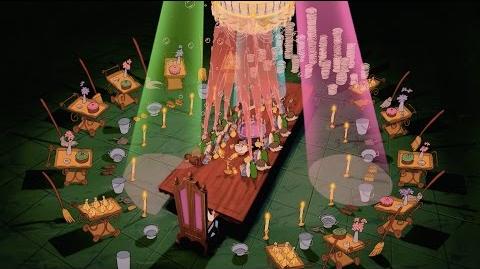
Beauty And The Beast Live Action Sneak Peek Bonus Clip

Beauty and the Beast US Official Trailer

Beauty and the Beast - International Trailer
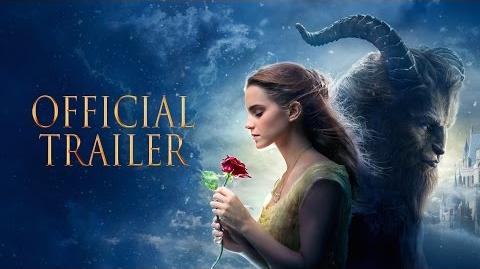
Beauty and the Beast – US Official Final Trailer

Ariana Grande, John Legend - Beauty and the Beast

Dan Stevens - Evermore (From "Beauty and the Beast")
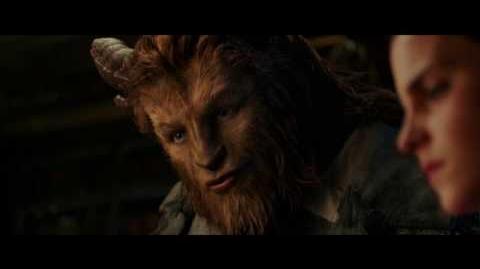
Beauty and the Beast - Bringing Beauty To Life

"Belle" Clip - Disney's Beauty and the Beast
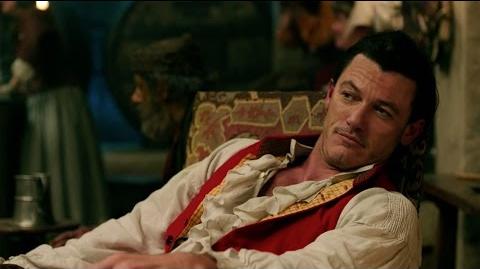
"Gaston" Clip - Disney's Beauty and the Beast
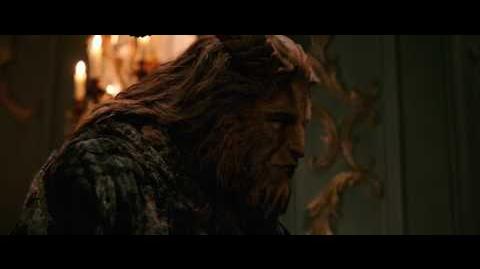
"Dinner Invitation" clip - Beauty and The Beast

"Empowered Belle" Featurette - Disney's Beauty and the Beast
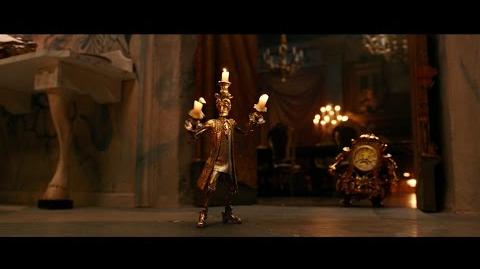
"Lumiere Plots Romance" Clip - Disney's Beauty and the Beast
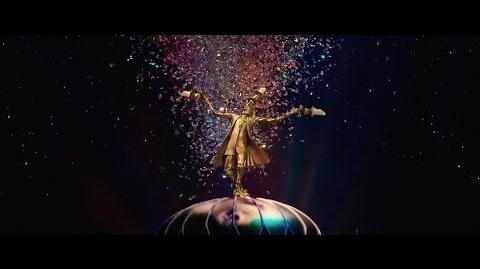
Disney's Beauty and the Beast - March 17 in 3D

Disney's Beauty and the Beast - Golden Globes TV Spot
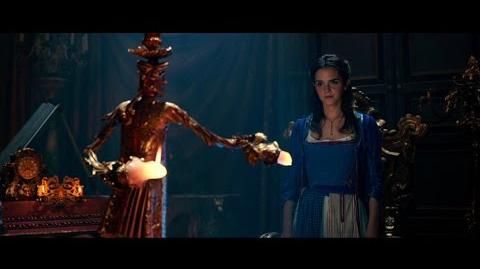
Disney's Beauty and the Beast - Academy Awards TV Spot
Interviews

Beauty and the Beast Emma Watson Official Movie Interview

Beauty and the Beast Dan Stevens Official Movie Interview
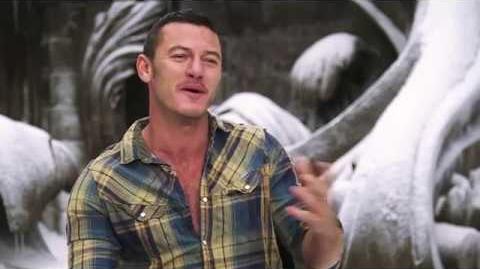
Beauty and the Beast Luke Evans Official Movie Interview
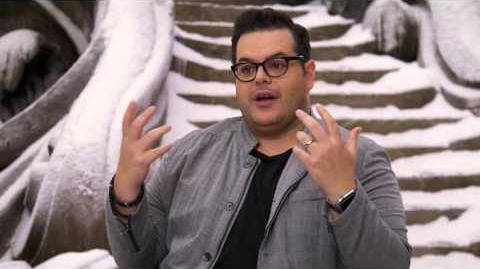
Beauty and the Beast Josh Gad Official Movie Interview

Beauty and the Beast Ewan McGregor Official Movie Interview

Beauty and the Beast Stanley Tucci Official Movie Interview
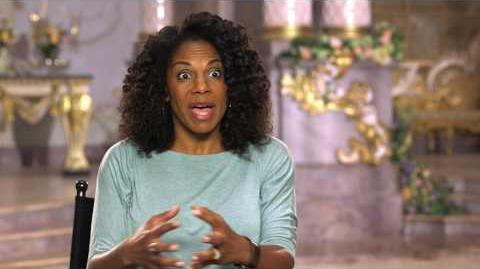
Beauty and the Beast Audra McDonald Official Movie Interview
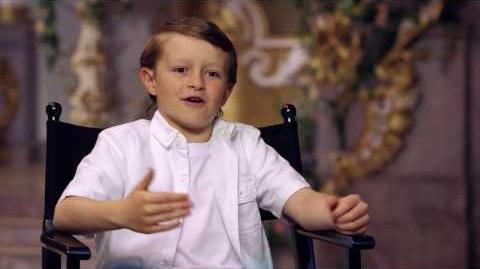
Beauty and the Beast Nathan Mack Official Movie Interview

Beauty and the Beast Gugu Mbatha-Raw Official Movie Interview
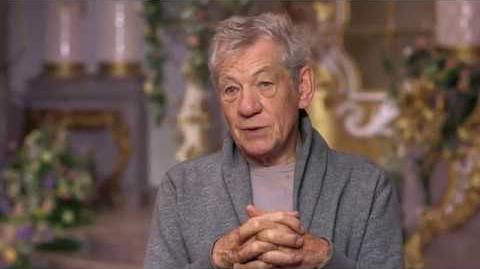
Beauty and the Beast Ian McKellen Official Movie Interview

Beauty and the Beast Emma Thompson Official Movie Interview

Beauty and the Beast Producer David Hoberman Behind the Scenes Movie Interview

Beauty and the Beast Composer & Songwriter Official Movie Interview - Alan Menken & Tim Rice
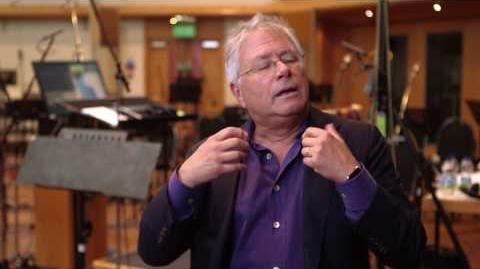
Beauty and the Beast Composer & Songwriter Official Movie Interview - Alan Menken

Beauty and the Beast Director Bill Condon Official Movie Interview
Trivia
- This is the fourth of many live-action adaptations of classic Disney animated films released in the 21st century, following Maleficent, Cinderella, and The Jungle Book (Pete's Dragon doesn't count as it is considered an adaptation of a live-action movie).
- This is the first live-action adaptation of a Walt Disney Animation Studios movie that is from the Disney Renaissance.
- The Blu-Ray/DVD features several deleted scenes, all of which are included in the junior novelization.
- The first is where Gaston is defending Belle from the villagers while she is doing her laundry and teaching a little girl to read (although his main intent is, of course, to show off for Belle, the villagers nonetheless listen to his directions because of how respected he is).
- The scene also notes that Gaston's tenure during the war were 12 years ago, while the finished film implies that his time in the army was more recent.
- Many scenes from the mob battle were cut. These include Clothilde trying to suffocate Lumière and Cogsworth coming to his rescue, Lumière saving Plumette from LeFou, LeFou being doused by Monsieur Toilette, and Froufrou luring the Villages Lasses into the kitchen where the stove drenches them with treacle and feathers.
- The first is where Gaston is defending Belle from the villagers while she is doing her laundry and teaching a little girl to read (although his main intent is, of course, to show off for Belle, the villagers nonetheless listen to his directions because of how respected he is).
- This is Kevin Kline's first role for a Disney film since he played Phoebus in The Hunchback of Notre Dame (which was directed by the same two directors who previously directed the original Beauty and the Beast) and The Hunchback of Notre Dame II.
- LeFou is Disney's first canonical gay character in a feature-length film.
- Josh Gad who played LeFou in this film, collaborated with the original voice actor of LeFou, Jesse Corti, in Frozen (as Olaf and The Spanish Dignitary, respectively).
- Bill Condon had actors sing The Lion King's "Hakuna Matata" at the auditions to measure their singing voices. This was how he chose the final cast for this film.
- This is the first live-action adaptation of a Disney classic to be composed and scored by the same composer as the original animated film (after this film, Alan Menken also return to score the following live-action adaptations for Aladdin and The Little Mermaid, while Hans Zimmer reprised his scoring for The Lion King).
- The teaser includes the opening music from the animated film and a piano sample of the title song.
- This is the fourth time that Emma Thompson does a role for a Disney film, after playing Captain Amelia in Treasure Planet, Queen Elinor in Brave, and P.L. Travers in Saving Mr. Banks, and Baroness Von Hellman in Cruella.
- This film marks Bill Condon's second collaboration with Dan Stevens and Stanley Tucci after The Fifth Estate, and the third collaboration with Sir Ian McKellen after Gods and Monsters and Mr. Holmes. Condon and McKellen next collaborate together for The Good Liar.
- This is Ewan McGregor's second movie-musical that takes place in France, the first being Moulin Rouge!.
- This is the second movie collaboration between Emma Watson, Stanley Tucci, and Kevin Kline following The Tale of Despereaux. Tucci and Kline previously worked in the 1999 version of A Midsummer Night's Dream.
- The Shakespeare play that Belle is reading to the Beast while he recuperates is "A Midsummer Night's Dream".
- This is the fourth movie collaboration between Ewan McGregor and Stanley Tucci following Jack the Giant Slayer, Robots, and A Life Less Ordinary.
- Ewan McGregor and Dame Emma Thompson previously worked on Nanny McPhee and The Big Bang.
- Actors Luke Evans, who played Gaston and Sir Ian McKellen, who played Cogsworth, previously collaborated in The Hobbit trilogy, in which Evans played as a bowman named Bard, while McKellen played as the wizard Gandalf; however, their characters did not interact until the finale of the trilogy. Ironically, in the trilogy, they played as allies whereas in this film, they played as enemies. In addition, both of the characters (Gaston and Cogsworth) in this film do not interact.
- Actors Stanley Tucci, who played Cadenza, and Dan Stevens, who played the Beast, previously worked together in Bill Condon's thriller film, The Fifth Estate.
- Actresses Emma Watson, who played Belle and Dame Emma Thompson, who played Mrs. Potts, previously worked in the Harry Potter franchise as Hermione Granger and Sybill Trelawney, respectively.
- Sir Ian McKellen originally turned down to voice the role of Cogsworth in the 1991 animated original.
- The production cultivated a total of 1500 "enchanted" roses for the movie.
- All of the wardrobe was made of sustainable materials that were eco-friendly.
- Interestingly, the actors Emma Watson (Belle), Luke Evans (Gaston), Emma Thompson (Mrs. Potts), and Nathan Mack (Chip) share the same birth date, April 15th.
- Emma Watson revealed that she wanted to play Belle instead of Cinderella, explaining that her personality associated much more with the former than the latter.
- The name of the village, Villeneuve, is a reference to Gabrielle-Suzanne Barbot de Villeneuve, who was the original author of the book Beauty and the Beast (or "La Belle et la Bête"), which was first published in the mid-1700's.
- Jacqueline Durran, the costume designer of this film, based the design of Belle's signature yellow dress on a sketch drawn by co-star Dan Stevens' young daughter Willow. According to Stevens, young Willow was very excited when told that Emma Watson would be coming to a home dinner at the invitation of Stevens. Eager to show and impress Watson, she had drawn several drawing sketches of Belle in various outfits, with the trademark dance dress standing out of the rest. The following day, Watson showed it to Durran, who took an immediate liking to it and started work improving the design of the dress.
- Production designer Sarah Greenwood based the town of Villeneuve on the French village of Conques in southern France. In addition, Greenwood also based the design of the Beast's castle on Baroque and Rococo architecture.
- Unlike the previous three live-action adaptation (Maleficent, Cinderella, and The Jungle Book), this film has no characters that are good in their debut but changed into villains in the remake (King Stefan for Maleficent, the Grand Duke for Cinderella, and King Louie for The Jungle Book). Unlike Maleficent, Cinderella, and The Jungle Book, all of the characters that are good in the animated version of their debut are also good in this film.
- Although in a way, the Bimbettes technically have that role since they are more malicious than in the animated film.
- LeFou is the second original Disney villain redeemed in the live-action adaptation, the first being Maleficent in the remake of the same name. He had more heroic qualities than his animated counterpart as he turned against Gaston in the climax for his constant mistreatment towards him, something the original LeFou would never do.
- LeFou being depicted in a more heroic light may have been a reference to the teaser poster for the 1991 original film, which depicted LeFou shining a spotlight on Belle and Beast.
- The Prince's cruel father is introduced in this remake as the root cause behind the events of the film. This makes the third time that a Disney villain is featured as a king in the live-action adaptation series besides King Stefan from Maleficent and King Louie from The Jungle Book.
- The line where Belle suggests that the Prince should grow his beard was originally an idea from Paige O'Hara when recording for the animated film. It was eventually cut.
- The scene in which Belle returns to her village while the beast, while singing "Evermore", is climbing up his castle to look out of a snowbound window to watch Belle going away in the distance bears a similarity from a famously heartbreaking sequence in Doctor Zhivago (1965).
- The scene in which Belle singed the titular reprise in a green meadow hills scenery bears a similarity from the opening title song and sequence in The Sound of Music (1965), which the scene pays a homage to, and in the same way that the animated original did.
- The scene during the "Gaston" song number, when Gaston chases LeFou while saying about sneaking up with his quiver in the tavern bears a similarity to the opening of the "Let's Get Married" number from Sunshine on Leith (2013). Both are set in taverns and both involve a character chasing another character and then standing up on the bar itself. There's also similarities to the Over and Done With number from Sunshine on Leith and the "Oom-Pah-Pah" number from Oliver! with characters dancing on tavern tables.
- Some of the scenes in the "Be Our Guest" song number that was featured in this film pays an homage of tributes to other musicals such as:
- At "culinary cabaret" sequence, it features a musical snippet of "Wilkommen" from the musical Cabaret.
- When the feather-dusters creates a fountain of which Lumière dances underneath it while using the Bouillon spoon as an umbrella, features the iconic scene from Singin' in the Rain (1952) in its title song.
- When Lumière is saying that "life is so unnerving for a servant who's not serving", he performs a shadow dance routine through the use of a handkerchief as a cover, in homage to the Cell Block Tango sequence from Chicago (2002), which Bill Condon wrote the screenplay for.
- The finale contains an Indian-style setpiece and a brief musical tone which features an Indian number, in homage to the musical film, Moulin Rouge! (2001) that also starred Ewan McGregor.
- The entire sequence of the song number was a direct homage on imagery of the great Hollywood musicals of Busby Berkeley.
- Also unlike the previous two live-action adaptations of Disney movies, there is no gender difference in any character in this remake (Jaq is a male mouse in the animated Cinderella film, but is female in the live-action remake of Cinderella and Kaa is a male snake in the animated version of The Jungle Book, but is female in the live-action remake). Also, the coat rack's gender was not specified in the original.
- Mrs. Potts portrayed by Dame Emma Thompson, also played Mrs. Lovett at the Lincoln Center performance of Sweeney Todd: the Demon Barber of Fleet Street in 2014. Her predecessor, Dame Angela Lansbury who portrayed Mrs. Potts in the 1991 animated version, played Mrs. Lovett in the original Broadway theater production of Sweeney Todd: The Demon Barber of Fleet Street in 1979. Additionally, Thompson and Lansbury also collaborated in Nanny McPhee (2005).
- Coincidentally, Thompson portrayed P. L. Travers in the biopic about the production of the 1964's Mary Poppins, Saving Mr. Banks; whereas Lansbury played the Balloon Lady in its 2018 sequel of the 1964 original, Mary Poppins Returns.
- Dan Stevens is the fourth actor from Downton Abbey drama series to have a featured role in Disney. His co-stars, Lily James and Sophie McShera previously appeared together in another Disney film, Kenneth Branagh's Cinderella as Cinderella and Drisella Tremaine while Ed Speleers plays as James Harcourt in 2016 Disney film, Alice Through the Looking Glass. Coincidentally, Lily James also worked with Dame Emma Thompson in 2015 drama film, Burnt.
- This is the first Disney live-action remake to gross over $1 billion (Tim Burton's Alice in Wonderland doesn't count, for that film portrays a different version of the story, rather than a direct remake).
- It is also the first movie of 2017 that grossed over $1 billion and is the second highest-grossing film of the year in which Star Wars: The Last Jedi took over as the top highest-grossing film of 2017.
- It is the highest grossing female-led movie domestically for 2017, after Star Wars: The Last Jedi and next to Wonder Woman which supplanted 1958 as the highest grossing year for female-led movies.
- Since Lucasfilm was bought by Disney in 2012, this film makes Ewan McGregor his third role in a Disney film after playing the title character in Valiant, followed by the Star Wars prequel trilogy (Episodes I to III) and Episode VII (as Obi-Wan Kenobi) and Christopher Robin (as the titular character).
- It is the second-highest grossing major Disney movie, the first being Frozen.
- This is Disney's second musical film to be released in 2017 within the same year next to Pixar's Coco.
- Tim Rice discusses writing the lyrics for the new songs in the film in his podcast Get Onto My Cloud.
- Emma Watson (Belle) was offered the lead role in Damien Chazelle's 2016 musical romantic comedy-drama film, La La Land but she turned it down in favor of playing Belle in this film. Coincidentally, Ryan Gosling was offered the role of Beast but turned it down to appear in La La Land, instead.
- In reference of that movie, Emma Stone coincidentally replaced Watson in the lead role for La La Land (of which Stone would eventually went on to win an Academy Award for that movie), and by ironic twist of fate, Stone would eventually ended up being replaced by Watson for the role of Meg March in Greta Gerwig's 2019 coming-of-age period drama adaptation of Little Women, due to Stone's scheduling conflicts in promoting the 2018 period black comedy film, The Favourite. In addition, Stone would also ended up starring as Cruella De Vil in its own 2021 Disney live-action spinoff of 101 Dalmatians titled as Cruella, opposite Dame Emma Thompson as Baroness von Hellman.
Cameos and other Disney references
- The suite played when Belle is first taken to her bedroom is from "Home", a song from the Beauty and the Beast Broadway musical that she usually sings in this scene.
- Some of the references in The Little Mermaid were featured in this film:
- The "Les Poissons" song is being referenced on the menu during the "Be Our Guest" song number.
- Cogsworth's line "So much for true love." which he uttered during the castle siege scene is the same line uttered by Ursula.
- During Belle and Beast's waltz, the letters WD can be seen in the coat of arms design on the floor of the Ballroom. This is a nod to Walt Disney.
- The padlock on the asylum carriage that Maurice and Belle are imprisoned in has a shape of a Hidden Mickey within its design.
- Also, a shape of a Hidden Mickey is also spotted within Cogsworth's eyes and nose in his clock form.
- Chip's movement particularly the matching saucer which he uses in moving around freely bears a resemblance of BB-8 from Star Wars: The Force Awakens.
- During the "Gaston" song number, LeFou is seen cracking the Baker's neck. This also happened twice in Atlantis: The Lost Empire, where Joshua Sweet adjusts Milo Thatch's neck.
- Gaston's red vest is lined with a yellow and red checkered fabric, the same pattern used for Woody's shirt in Toy Story.
- Two iconic landmarks from two Disney animated movies made a cameo in this film:
- The Sultan's Palace of Agrabah from Aladdin in which the animated version of the Beast makes a cameo appearance as one of Sultan's toys. Appears twice, first in a form of a replica model in the music boxes and second as a posh model featured during the "Be Our Guest" song number.
- Notre Dame Cathedral from The Hunchback of Notre Dame in which Belle from the animated film makes a cameo appearance.
- Belle's childhood in Paris can be seen as a nod to her cameo appearance in The Hunchback of Notre Dame during the song "Out There".
References
- ↑ "Disney's Live-Action Beauty and the Beast Set for March 17, 2017". Variety (October 26, 2016).
- ↑ 2.0 2.1 You must specify title = and url = when using {{cite web}}..
- ↑ "2017 Feature Film Study". FilmL.A. (August 8, 2018).
- ↑ Christian Sylt (June 8, 2018). "The $255 Million Spell That Disney Cast On Britain".
External links
| v - e - d | ||||||||||||||
|---|---|---|---|---|---|---|---|---|---|---|---|---|---|---|
|
Next Disney Live Action Movie After Beauty and the Beast
Source: https://disney.fandom.com/wiki/Beauty_and_the_Beast_(2017_film)
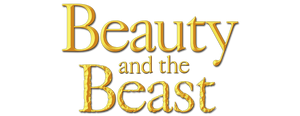
0 Response to "Next Disney Live Action Movie After Beauty and the Beast"
Enviar um comentário